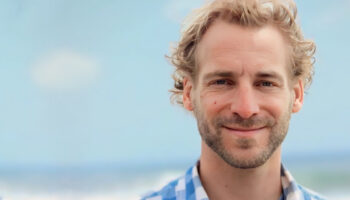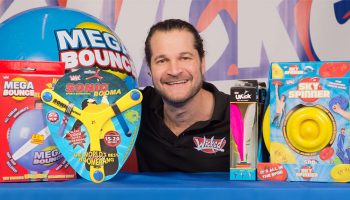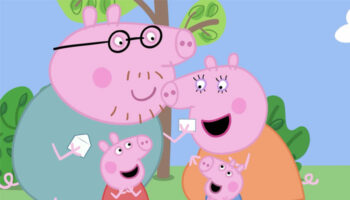Putty in his hands: Crazy Aaron – aka Aaron Muderick – reveals why he revels in his genre-defining products

Thanks for joining us, Aaron. I’m genuinely thrilled to see you! Many people are going to know you from your alter ego, Crazy Aaron. But for the uninitiated, who are you and what do you do?
Well, Crazy Aaron is a real person – me! I’m Aaron Muderick; I live in Philadelphia – and for 25 years I’ve been on a mission to make the best putty in the world, supplemented by the most amazing dough and incredible slime. The attention to detail and the sensory experience in those compounds is my obsession and what I work on every day.
Great! You say you’re on a mission to make the best putty in the world. What does “the best” mean to you?
So what the best to me means is the most incredible sensory experience. And ultimately, this is an artist’s choice, right? You know, we sit at a table with engineers and chemists, and we pass things around, and play with them. Then I more or less say, “I like it!” or “I don’t like it…” But I try really hard to sit on the floor and play with children and get my head around what it means to be nine years old again.
To empathise?
Right, to try and understand what will be the most appealing, what are all the little characteristics, whether it’s stickiness or sensory, or just the way it pulls or the way it falls apart when you stretch it too thin. All of those little details: what makes it a pleasant experience?
Sounds like it’s literally a hands-on process; one that’s driven by gut instinct?
That’s absolutely right.

Well, you know what? We could stop this conversation right now and I would already have loved it! Let’s push our luck, though; see if it holds. I understand you’ve worn many hats in your life… Tell me about some of them.
I have worn many hats. I trained to be a software engineer, majored in computer science. I did that for a number of years; early internet, working in Silicon Valley, designing internet-enabled operating systems, graphics engineering and such. And as you can imagine, you’re always up- and downloading files and waiting for things to compile when you’re writing code – so I’d often find my hands were free while I was waiting… And so I ended up accumulating different toys to fiddle with, really. One of the things I started playing with, and became obsessed with, was that old egg of putty.
Silly Putty?
Silly Putty. That was my go-to every day. But it was weird… I realised, day by day, that my ball of putty kept getting smaller, and was just a little less satisfying. I couldn’t figure out why. Then, I laid a trap… I said I was leaving my cube to go get lunch, and then immediately doubled back and discovered the truth: my coworkers were stealing little pieces to play with for themselves!
They were nicking the putty – putty theft!
They were nicking the putty! So that was a light bulb moment for me – I thought maybe I’d stumbled into something. Ha! So then – being in my early twenties – I wanted to sort of impress my internet buddies and I started to wonder: how can we have a lot of this stuff? And actually, the first thing I did was peck away at the Silly Putty manufacturer to send me a hundred pounds of it. Ha! Eventually, they were like, “All right, if you send a check and wait 21 days for it to clear, we’ll do it – just this once!” So it was really a hobby that became a career.
And what happened to that 100-pound mother lode?
Well – being that I was working for an internet company that was growing very, very quickly, it was all distributed out to the staff. But then there were all these new staffers three months later! So then I got into thinking maybe I could figure out how to make this myself to be more cost effective… Because, at that time, I was selling everything at cost.

Eventually, my coworkers thought I was so obsessed with the putty that I was neglecting my work. Which is how I got my name, by the way… They were like, “You’re gonna get fired! You’re crazy, Aaron!” Ha! But also – and this was very important – there was a second spark in learning how to make it. I realised it didn’t have to be made the way it had been.
You mean in terms of tweaking the recipe, for want of a better word?
Right. I realised that there were lots of decisions made by chemical engineers and the like over the last 50 years. And mostly those decisions would have been concerned with reducing cost – not with making it more beautiful, more amazing, or more incredible to feel. But with my being less cost oriented, because I was entertaining myself, I went down the path of making putties that did things no one had ever seen before.
Wow. This makes absolute sense because when I looked at your website, my mind bent a little at the sheer range. But presumably there is, to some degree, a different tweak to every recipe. Try this, try that, see if it will do different things?
That’s right. And different additives, too. I often say that the best invention doesn’t come from someone having a magical idea, fully formed, coming out of their head wholly formed. Right? The best invention – if you study invention as a discipline – comes from connecting unconnected dots.
I agree completely, completely!
By way of example, someone in the oil industry discovered an additive that helps with fracking. To them, that’s all it does… But if you’re a physician who’s trying to do eye surgery, and you’re like, “I need something to lubricate this surgical tool as it goes in…” Well, guess what? There’s this thing over there! So now you’re connecting the dots and you’ve made an invention and discovery. What I try to do is immerse myself in lots of careers and professions and industries that are not toys and find the areas where the secret sauces are hiding that I can bring into the toy domain to do things that no one else has.
Oh, my word. Aaron, you are absolutely talking my language. Ha! I’m a hundred percent with you. I get the sense there are more arrows in your quiver, though… How else do you stay creative?
In addition to looking at other industries, I look at art. Art is where people are just dedicated to creative expression and seeing the world in a different way. So artists might ask, “What does a rose sound like?” Or, “What is the scent of a beautiful day? Those sorts of juxtapositions. In consumer products, we’re working with people to whom you’re saying, in effect: “This is product X, and it does this.” But really, what am I selling to the consumer? It’s actually an experience and an idea – something in their mind. So I need to meet them where they are. I need to follow the zeitgeist. Staying connected to the art world and what’s happening in those spaces is important to me.

Wow. Love it. So, Aaron – let me ask you this. When you’ve got so many options to tweak this or tweak that, how do you know what deserves to be a product?
I like to do proof of concept. I like to put the extra effort into making things, because part of the inventive process is also the unexpected. I’ve had a number of successful products which were ‘impossible’ until we just stopped talking about why it won’t work. Throw some ingredients together and feel what comes out… Don’t overanalyze!
You know, we’re not as smart as we think we are. Also, I trust focus groups, I trust testing. That can be informal. It can be myself… I put these things on my desk. If there’s three or four of them in front of me, I notice which is the one I keep picking up to play with. I also put them in meetings. And, of course, we have a retail store at our headquarters, which gives me the opportunity to put in front of children and see first-hand.
Just to clarify, you have – at your head office – a retail store that’s selling just your product?
Well, we have a few other curated brands. But it’s predominantly putty, yes.
So you’ve got that market research tool. You put it there and it tells you there and then how well is this going to sell?
That’s right. And working with store staff who know what I’m looking for. Even before some things are on sale, the store manager will say to the kids that come in, “Hey, let me show you something. What do you think of this?” And I can get feedback. I can go and watch through the window. I have that opportunity to see how kids are interacting.
That’s brilliant. How soon in your journey did you start doing that?
Well, it was later in the journey. The store is five years old next month. Before that, I had younger children; I had lots of children around in my life. So the store was sort of recognizing that my kids are not kids anymore and that I’m going to need to find another test audience.

You know, I’m going to have to confess, I’m a complete neophyte here… I’ve never made slime and I’ve never made putty. How do you make putty on an industrial scale?
Putty is not something you can make at home. It requires a more industrial process and industrial materials. Unlike some slimes, you can’t buy the ingredients at the grocery store and just sort of, you know, mix it together like contact lens cleaner and dishwashing soap and so on. Putty is more of a chemical-engineering process. It’s primarily a silicone rubber.
I was also very interested to hear about your accommodating special needs in the workforce. Tell me about that.
From the beginning, I wanted to have my hands in the putty. I was able to develop these products not by calling a factory asking for X or Y, or describing what I wanted. Rather, I’d just do the experiments and get my own results. But when the business finally grew to the point where I couldn’t do it all myself, I thought about the workforce I’d want. Well – back in high school, I’d worked at a factory that made dog tags – you know, like for pets; for collars…
Like name and address tags?
Right. They had a number of individuals working there, in various roles, with intellectual disabilities. I remember quite clearly that they were the most positive, upbeat and satisfied people. And the jobs they did were ideally suited to their level of challenge. What you or I might consider repetitive wasn’t boring to them – they were very engaged in their work.
Yes, the idea of doing a repetitive task is anathema to many people… But for certain individuals with challenges, that’s ideal.
Absolutely. And there came a time when I knew I couldn’t just keep hiring high-school kids to work in my basement to get the work done. I mean, I was running three shifts in my basement for a couple months to get through one Christmas. It was insane. Ha!

And where was this, Aaron? In a factory?
No! I was in this little house on a quiet residential street! Whenever a truck turned up, it blocked the road. A trailer dropping off metal tins got stuck in the snow once… And the drivers used to come by; they’d get so mad because we didn’t have a loading dock – they’d throw these rubber compounds off the back of the truck. They’d just push the pallet off the end.
I’m imagining putty bouncing all over the street like Flubber!
Eventually, I wanted to build something bigger. I needed a facility. And I wanted to hire people who wanted to be there. My worst nightmare was the idea of taking something I love and turning it into a management job where it sucks all the life out of me. That being the case, I got connected – through a neighbour – with a social-services organisation that helps individuals with intellectual and physical disabilities connect with companies.
They facilitated that process for you?
Yes, they provided the nexus for everybody to come together and start – you know, “Here are some tins. Can you put some stickers on?” Then maybe, you know, “Can we break up the putty?” And then, later, “Let’s install some machinery and equipment at your facility and train people on how to make the products from scratch.” Over many years, that’s grown and developed. Before the pandemic there were about 800 individuals at nine different facilities.
Wow. And this is in the US, is it not?
Across the Philadelphia area, yes. They were doing this work every day, Monday through Friday, 52 weeks a year – putting our product together. And with a very wide range of challenges; low-functioning to high-functioning individuals with mental health issues, and citizens coming out of prison – all of these different walks of life.
That’s absolutely remarkable. I mean, an awful lot of people would not, I think, want to take that risk in the first place. But you’re showing that there’s a way to get something out of people that many wouldn’t even look at – and in a way that doesn’t diminish them. It builds them.
And I feel very lucky to have been able to execute that. But really it couldn’t happen without the support of our customers believing in our products and believing that there was value in transforming product in a $1 egg into a big heaping handful for $15 in a bigger tin. That’s what lets us support that ideal, and what allows it to happen.

Brilliant. I’m so glad I asked because that kind of creativity really is the kind that changes lives. It’s impressive that you’ve realised – literally realised; made real – that there’s potential in people that many businesses wouldn’t even bother to look at. I’m quite moved.
Thank you, Deej.
Okay… Let’s go from the sublime to the ridiculous. It doesn’t surprise me to learn you have some interesting hobbies. What are some of those?
Well… I don’t know that this is a hobby, but I’m a volunteer firefighter…
Course you are. Ha!
Ha! So… Ha! So at the drop of a hat, I will run out of here and put on my gear and go run into a burning building. I do enjoy that work… Is that a hobby?
Ha! I should know?! I mean… Do you enjoy it to the point that you’re setting the fires to have something to do?
No, no, no, no, no, no! Although, you know, on the other side, I have also been a pyrotechnics chief for 4th of July events here in the US… Setting off big firework shows. But no, the firefighting is strictly about putting out the fires!
Well, that sounds like a very courageous vocation to me rather than a hobby, but… How does your family feel about it?
Naturally, they worry when they hear the sirens multiplying in the neighborhood. It’s understandable.
Fascinating. And you collect playing cards, I understand?
Oh, the playing cards. Yeah. Do you want to see some? Hold on… Here’s my book. Let’s see here. So I finished my first deck – it took me 20 years, from 1999 to 2019. And this is the one I started in late 2019. I’ve got the different cards here along with where and when they were found.
Let me just get this clear… You’re not collecting new packs of playing cards?
No, no, no, no. I have no interest in that. These are found in the street, blowing in the breeze.
You’re just walking around; you look down and there’s a playing card in the gutter. You pick it up and hope it’s a card you need?
Exactly. This one was found in Alaska, January 2022. This one here was found on the street in the Sierra Nevadas in October 2021. And you know, it goes on and on. This card is really cool… Look, I got a giant one. And this one was found on the streets of Brooklyn, New York. In about 16 years or so, I’m hoping this deck will be finished. And, you know, that’ll be exciting.

Exciting, yes. And absolutely bonkers. Does it matter who finds the playing card? Do you have to find the playing card yourself?
No, it doesn’t have to be me. It’s a small group of close friends and family who help me. They’ll find a card and they let me know where and when. Otherwise, I think it would take a lifetime to do a whole deck. The thing is, I’ll find maybe three or four a year because I like to walk, so I’m out a lot, you know, walking around. But even if you find a couple a year, it’s hard hard because they all need to be unique. So when you start a new deck, you’re like, “Great, I don’t have this one!” But as you get 30 or 40 cards, the odds that you’re going to find a unique card shrink dramatically.
I get that! As you get closer to finishing, the less likely it is that you’ll finish… Well, I’ll keep my eyes peeled. I do see playing cards in the street every so often; sometimes I’ll do a magic trick with one for someone I’m with… But after that – you know, it’s up for grabs!
Send it to me Deej! Send it on. Put it in the collection.
That’s perfect – I was looking for an excuse to be in touch with you three or four times a year! I’m totally in; I’m won over!
I’m glad you’ve been won over! It’s exciting. People get into it, you know. It’s a special collection you can’t buy your way into. This is really the luck of the draw. You don’t know when life is gonna deal you one these cards.
Well look, Aaron – nothing about this chat has been anything but a joy. I’ve loved it from beginning to end. Last question – and I almost daren’t ask – What’s the most interesting object in your office or on your desk?
Hmmm. The most interesting thing I’m looking at, in my curios here, are – what would you call them? Not artefacts… Oh my gosh, what’s the word? You know, like when you have like the finger of a saint or something?
Um… The finger of a saint? Like relics?
Yes! Relics is the word; I do love relics. And I’ve actually been able to mix some of them into my putty…
You what?!
I made a putty with ground up pieces of the Statue of Liberty in it one time…
Oh! I thought you meant the finger of a saint! Ha!
Ha! No, no, no, no! That wouldn’t be allowed!
No, well – I was a little taken aback… Like, ‘Touched by God Putty’. But no – other relics!
Right. So I have some coal from the Titanic. They brought it up… Some metal from the Statue of Liberty that I saved for myself. I have a very tiny slice of a piece of Abraham Lincoln’s bloody shirt. I don’t have saints’ fingers, though. Ha!
Ha! Sounds like I’ve found a hole in your life. Aaron, I’m so pleased to have finally caught up with you – you’ve been on our wish list for a few years, and you’ve exceeded every expectation. Thank you for making time.
–
To stay in the loop with the latest news, interviews and features from the world of toy and game design, sign up to our weekly newsletter here


























